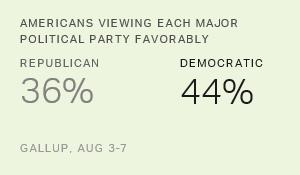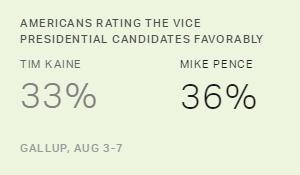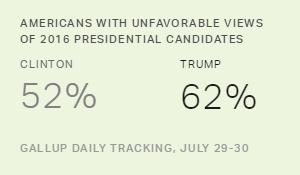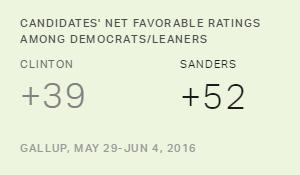Story Highlights
- Clinton's 39% and Trump's 32% favorable ratings very similar to early July
- Both saw their images improve during the conventions, but that didn't last
- 73% of Democrats see Clinton favorably; 68% of Republicans like Trump
PRINCETON, N.J. -- Americans' views of Donald Trump and Hillary Clinton are almost exactly the same now as they were in early July before their party's convention. Both of their favorable ratings improved after their party's convention, but those higher ratings did not persist.

Trump's favorable rating became slightly more positive in the Republican convention environment, rising to 37% and for the first and only time in . Then, as the Democratic convention was wrapping up, Clinton's favorable rating rose to 42%, and the gap between the two candidates' ratings expanded to 10 percentage points.
These shifts in the public's views of the two candidates were short-lived, however, and their images have now returned to where they were. Clinton is once again enjoying a modestly more positive image than Trump. Any hopes that either campaign had of using the conventions to create a major, lasting shift in Americans' images of the candidates did not materialize.
Partisans' Views of Their Candidates Also Little Changed
One of the traditional purposes of the summer political conventions is to rally each party's base around their candidate. But, as was the case for national adults, Democratic and Republican views of their party's nominee barely budged.
Seventy-three percent of Democrats (including Democrat-leaning independents) are positive about Clinton, similar to the 70% who rated her favorably prior to the conventions. Similarly, Trump's favorable rating among Republicans (including Republican-leaning independents) is 68%, up only three points since before the conventions.

This lack of improvement in partisan favorability was not what either campaign would have liked. Democratic Party unity had been roiled prior to the convention by many Democrats' loyalty to Bernie Sanders. The Vermont senator endorsed Clinton and said he was "proud to stand with her" in his convention speech, and while that may have helped boost her image among Democrats in the short term, it didn't create a major, lasting shift.
Trump too would have certainly liked to see improvement in his image among Republicans as a result of his convention. Trump's campaign had its own unity challenges, with establishment Republicans' reluctance to embrace his candidacy and an ugly primary campaign between Trump and his numerous GOP opponents. However, Trump's image among Republicans has ended up just marginally better than where it was in early July.
While Clinton's 73% approval rating among Democrats is slightly higher than Trump's 68% rating among Republicans, the historical record shows these are low compared with how partisans have evaluated their party's nominee in previous years. As one example, 94% of Republicans viewed John McCain favorably and 91% of Democrats viewed Barack Obama favorably in a Â鶹´«Ã½AV poll conducted in September 2008 after both of that year's conventions. This underscores one of the unique features of this election -- the negative aura which surrounds both major party candidates.
Implications
The conventions produced no major reset in Americans' or party loyalists' opinions of Clinton and Trump. Americans' views of the two candidates are basically back where they started in July.
With both candidates having historically high unfavorable ratings this year, many Americans may have to carefully assess their priorities in a "lesser of two evils" calculation when it comes to their vote -- if they vote at all. But the candidate with the most favorable image in presidential elections, and both Trump and Clinton would presumably like to craft more positive images as the campaign progresses.
Separate Â鶹´«Ã½AV research shows that over seven in 10 Americans continue to having read, seen or heard something about the candidates each day, giving Trump and Clinton at least a theoretical chance of altering people's perceptions of them. Beginning on Sept. 26, the three scheduled presidential debates will also provide a chance for the candidates to boost their images. The results of tracking through the conventions, however, suggest it may be hard to change opinions of the candidates in this election.
These data are available in .
Survey Methods
Results for the most recent candidate favorable ratings are based on telephone interviews conducted Aug. 3-9, 2016, on the Â鶹´«Ã½AV U.S. Daily survey, with a random sample of 3,566 adults, aged 18 and older, living in all 50 U.S. states and the District of Columbia. For results based on the total sample of national adults, the margin of sampling error is ±3 percentage points at the 95% confidence level. All reported margins of sampling error include computed design effects for weighting.
Each sample of national adults includes a minimum quota of 60% cellphone respondents and 40% landline respondents, with additional minimum quotas by time zone within region. Landline and cellular telephone numbers are selected using random-digit-dial methods.




